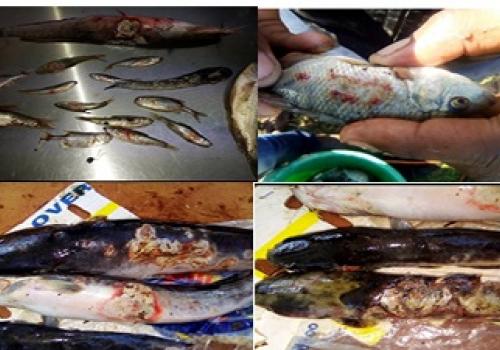The Ministry of Agriculture of the Government of the Republic of Malawi on the 29th July 2020 announced a suspected incursion of Epizootic Ulcerative Syndrome (EUS) in the Mchinji District, bordering the Zambian town of Chipata. This is following reports received from Mchinji District Fisheries Office, fish farmers and fishers during mid-July 2020, where fish kills of species like Clarias gariepinus (catfish), Oreochromis shiranus (chambo/tilapia), and Barbus paludinosus (straight fin barb) were observed and dead fish had ulcerative lesions on their skin.
EUS is a seasonal epizootic condition of great importance in wild and farmed freshwater and estuarine fish. The fungus involved in EUS is also known variously as Aphanomyces invadans, A. piscicida, A. invaderis and ERA (EUS-related Aphanomyces). It occurs mostly during periods of low temperatures and after periods of heavy rainfall. These conditions favour sporulation of A. invadans, and low temperatures have been shown to delay the inflammatory response of fish to fungal infection. EUS is transmitted from one fish to another through the water supply. The susceptible life stages of the fish are usually juvenile and young adults. There is no report of EUS being found in fish fry or fish larvae. When EUS spreads into a fish culture pond, high morbidity (>50%) and high mortality (>50%) might be observed in those years that have a long cold season, with water temperatures between 18 and 220C. Some infected fish may recover when the cold period is over.
Samples were taken during inspection of affected areas and were sent to the University of Zambia’s School of Veterinary Medicine Laboratory, which is a Regional Diagnostic Centre for fish diseases. Unfortunately, histopathology and Polymerase Chain Reach (PCR) tests came back positive. Since EUS is a notifiable disease, the World Animal Health Organization (OIE) was notified, and so far, the Government of Malawi has put in place measures to prevent further spread of the disease as such:
- Temporary suspension of transportation of and selling of live or dead fish around the Bua river system and surrounding fish farms.
- Suspension of fishing from the infected rivers and dams.
- Fishers were also advised to avoid the use of same fishing equipment used in the infected waters to other water bodies.
- Communities were also advised to avoid carrying water from the infected rivers and fish ponds to other water bodies.
This is the first ever incursion of EUS in Malawi, and can affect livelihoods of over 55,000 fishers in and around Lake Malawi, and this number can be more if we include processors and traders. The situation also poses a serious threat to the regional fisheries and aquaculture sector, especially in the Zambezi River Basin.
SADC Secretariat convened the meeting of the Regional Emergency Task Force on EUS to develop a roadmap and coordinate efforts to address this situation. The Task Force consisting of affected Member States namely; Malawi and Zambia, and regional partners Food and Agriculture Organization of the United Nations (FAO), OIE and WorldFish, recommended:
(i) Urged that neighboring countries to be on alert and to conduct investigations and engage in passive surveillance and report any suspected cases to national and regional authorities;
(ii) Development of a plan to undertake scientific outbreak investigation in Malawi;
(iii) FAO in partnership with SADC and OIE to set-up an online training course within the next two weeks on designing an active surveillance for EUS and its implementation;
(iv) SADC and FAO to develop a Technical Cooperation Programme (TCP) to engage in more scientific outbreak investigations, including epidemiological analysis in the region, capacity building and awareness creation; and
(v) SADC to mobilise resources to support efforts by countries to develop emergency preparedness plans, including domestication of the SADC Aquatic Animal Health Strategy (2016-2026).
For more information regarding country-level case reporting, advisory and extension, please contact responsible Ministries and Departments of Fisheries and Aquaculture and Veterinary Services.
For further information, please contact SADC Secretariat, Dr Motseki Hlatshwayo at mhlatshwayo@sadc.int, and partners: FAO Southern Africa Office, Mr. Vasco Schmidt at Vasco.Schmidt@fao.org, and OIE Southern Africa Office, Dr Ólafur Valsson at o.valsson@oie.int.
| Attachment | Size |
|---|---|
| Regional_Press_Release_-EUS_disease_Outbreak_in_the_SADC_region.pdf | 281.18 KB |

